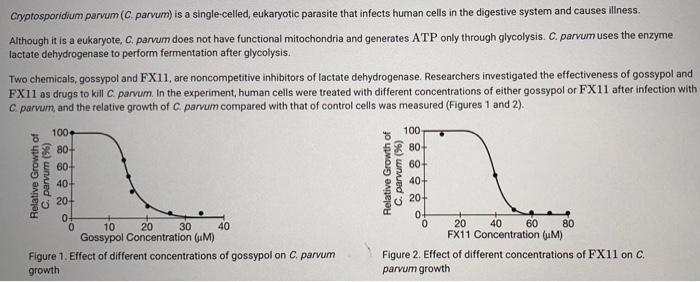Question
(a) Describe how C. parvum obtains the glucose it needs for glycolysis after it has infected another cell. Explain the role of lactate dehydrogenase in

(a) Describe how C. parvum obtains the glucose it needs for glycolysis after it has infected another cell. Explain the role of lactate dehydrogenase in enabling C. parvum to continue producing ATP by glycolysis.
(b) Identify the independent variable used in the experiment. Identify the difference between the control cells and the experimental cells used in the experiment. Justify the researchers using a different range of concentrations for FX11 than was used for gossypol.
(c) Based on the data in Figure 1, identify the concentration of gossypol that reduced C. parvum growth to 50% of that in control cells.
(d) Researchers discovered a strain of C. parvum that expresses a functional variation of the lactate dehydrogenase gene. A DNA sequence comparison showed that the variant differs from the normal sequence in the region that codes for the enzyme’s allosteric site. Predict the effect of FX11 treatment on C. parvum cells that express this variant of lactase dehydrogenase. Provide reasoning to support your prediction. Explain how gossypol and FX11 might be used as drugs to treat C. parvum infections in humans without negatively affecting human cells.
Cryptosporidium parvum (C. parvum) is a single-celled, eukaryotic parasite that infects human cells in the digestive system and causes illness. Although it is a eukaryote, C. parvum does not have functional mitochondria and generates ATP only through glycolysis. C. parvum uses the enzyme lactate dehydrogenase to perform fermentation after glycolysis. Two chemicals, gossypol and FX11, are noncompetitive inhibitors of lactate dehydrogenase. Researchers investigated the effectiveness of gossypol and FX11 as drugs to kill C. parvum. In the experiment, human cells were treated with different concentrations of either gossypol or FX11 after infection with C. parvum, and the relative growth of C. parvum compared with that of control cells was measured (Figures 1 and 2). 100 100 80+ 80- 60- 60 40- 40- 20- 20- 0- 40 60 FX11 Concentration (uM) 10 20 30 40 20 80 Gossypol Concentration (uM) Figure 1. Effect of different concentrations of gossypol on C. parvum growth Figure 2. Effect of different concentrations of FX11 on C. parvum growth Relative Growth of (96) unJed o Relative Growth of C. parvum (%)
Step by Step Solution
3.49 Rating (166 Votes )
There are 3 Steps involved in it
Step: 1
rsiti rgnisms btin their resures frm their hsts in this se rvum uses the gluse frm the infeted tissu...
Get Instant Access to Expert-Tailored Solutions
See step-by-step solutions with expert insights and AI powered tools for academic success
Step: 2

Step: 3

Ace Your Homework with AI
Get the answers you need in no time with our AI-driven, step-by-step assistance
Get Started


